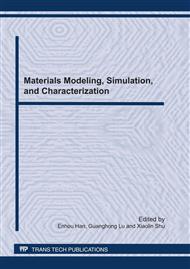p.321
p.328
p.336
p.343
p.350
p.355
p.361
p.367
p.372
Fabrication and EIS Characterization of Titania Nanotube Arrays with Top Non-Tube Layer
Abstract:
TiO2 nanotube arrays were fabricated in the electrolyte containing 0.25wt% NH4F, 2.5vol% water and the ethylene glycol for various hours at room temperature by anodization of Ti foil in this paper. Some anodized specimens were annealed at 450°C for 3 hours. Electrochemical Impedance Spectroscopy (EIS) was employed to measure electrochemical parameters of anodized specimens. The morphology and crystalline structure of anodized products were characterized by Field Emission Scanning Electronic Microscopy (FESEM), X-ray Diffraction (XRD) and Transmission Electronic Microscopy (TEM). A non-tube layer appears on nanotube arrays with the increase in anodization time. Anodized TiO2 nanotube arrays have an amorphous structure, which transfers to anatase structure after annealing at 450°C. A new equivalent circuit R(CR(R(QR)(CR))) was proposed to fit EIS data. The results show that the charge transfer resistance at the electrode/electrolyte interface controls the electrochemical process of TiO2 nanotubes.
Info:
Periodical:
Pages:
350-354
Citation:
Online since:
June 2011
Authors:
Price:
Сopyright:
© 2011 Trans Tech Publications Ltd. All Rights Reserved
Share:
Citation:


